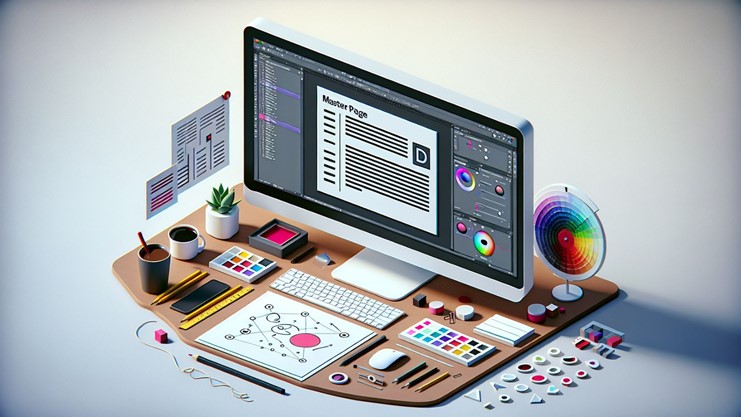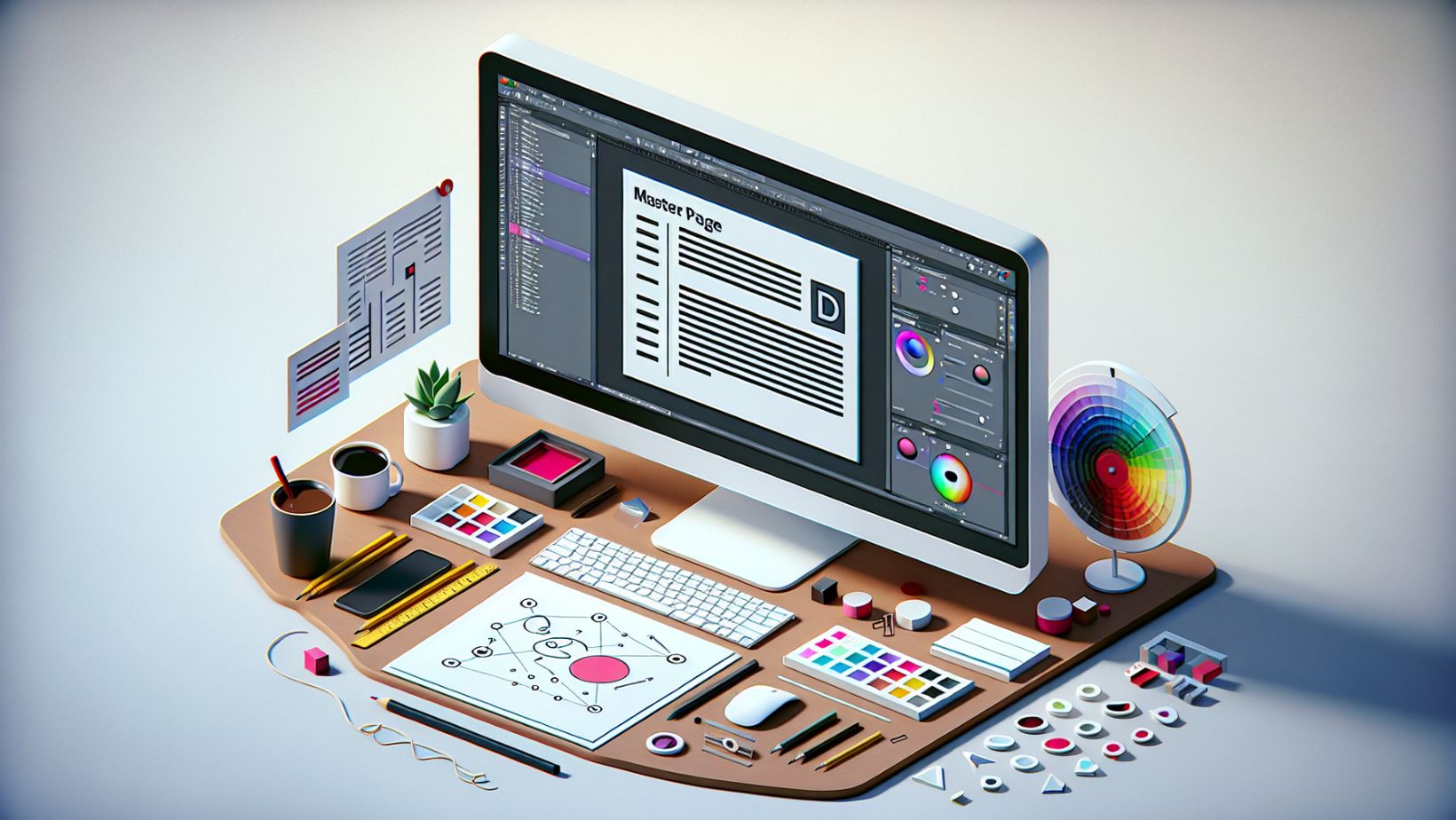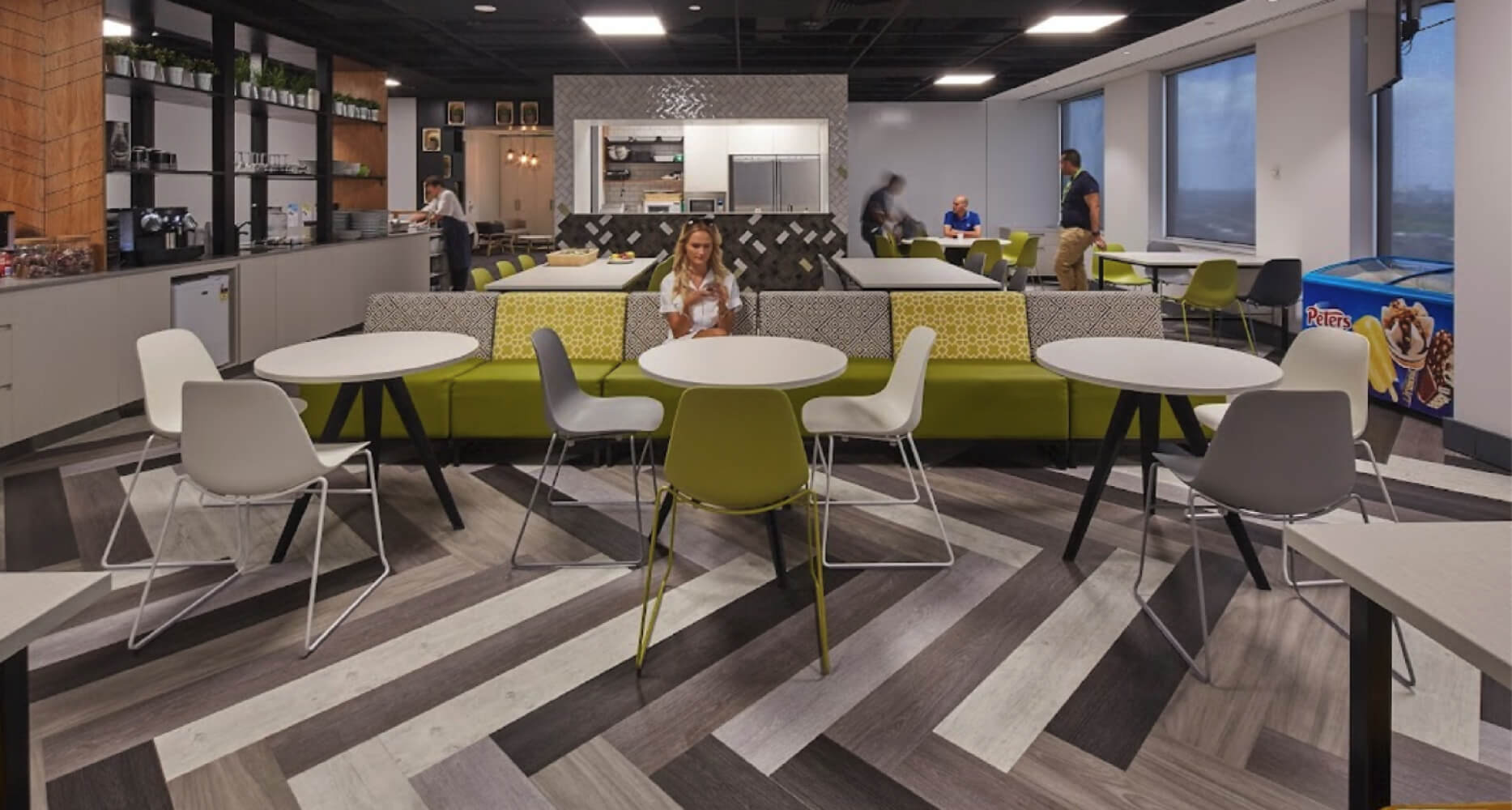Is InDesign beginner-friendly? Absolutely. Adobe InDesign welcomes novices with tools that simplify complex design tasks, a user-friendly interface, and extensive online resources. We break down the essentials of starting with InDesign and how its supportive environment accelerates the learning curve for beginners. Explore the comprehensive capabilities of InDesign, whether creating your first flyer or assembling a portfolio, and find out why it’s a top choice for new designers.
Navigating the Basics of Adobe InDesign

Adobe InDesign greets beginners with open arms, offering an accessible platform to translate imagination into tangible designs. This desktop publishing marvel boasts an intuitive environment where the first steps are as exciting as they are easy to grasp.
Whether you’re piecing together your inaugural newsletter or laying out a dream portfolio, InDesign’s accommodating nature ensures a smooth ride from the get-go.
Starting Your First Project
The adventure begins when you create a new InDesign document. Click on ‘Create New’ or use a simple keyboard shortcut, and a dialog box will present a canvas specially designed for your project. Print, Web, or Mobile—you name it, InDesign caters to it with presets that set the stage for your creative performance.
For those who like to fine-tune every aspect, custom settings invite you to specify dimensions, margins, and even bleed values, ensuring your document fits the narrative of your design perfectly, depending on your settings.
Familiarising With the Interface
The InDesign software interface serves as your creative command centre, providing a comprehensive set of tools and panels to materialise your vision. The workspace can adapt to your workflow with panels and tools that can be moved, docked, and hidden as you please. Tooltips hover by your side, offering guidance, while the ability to customise the interface means you’ll never feel lost.
Basic Operations and Shortcuts
Shortcuts are the keys to efficient workflow in InDesign. These special keystrokes expedite your design process, leaving more room for creativity. Some commonly used shortcuts in InDesign include:
-
‘V’ for the Selection Tool
-
‘T’ for the Type Tool
-
‘C’ for the Crop Tool
-
‘P’ for the Pen Tool
-
‘B’ for the Brush Tool
A click and a drag can animate your text frames, and the Pages panel can help you maneuver through your masterpiece. And when it’s time to duplicate or undo, shortcuts are there to ensure your focus remains on crafting, not clicking.
Mastering Text and Typography
In graphic design, text is not merely a sequence of words; it becomes the very essence of your design's narrative. Adobe InDesign acknowledges the power of typography, offering an extensive array of tools that empower designers to ensure their message is delivered.
With the right guidance, even beginners can master the nuances of leading, kerning, and everything in between.
Adding and Formatting Text
Consider the Type tool as your quill and the text frame as your parchment in InDesign. Here, you craft the narrative of your design, with numerous formatting options at your fingertips. Whether it’s adjusting the font size, switching typefaces, or colouring your words, the Control panel is your gateway to character customisation. With the Eyedropper tool, you can transfer these settings between text boxes.
Leveraging Adobe Fonts
The Adobe Fonts library reveals several typefaces for your InDesign projects. Thanks to the Auto-activate feature, the days of font frustration are over; missing fonts are automatically retrieved with no interruption to your workflow.
Paragraph Styles for Efficiency
Paragraph styles enable consistent text formatting with a mere click. These styles are your secret weapon for maintaining a uniform look across your document, with advanced options that transform ordinary text into eye-catching elements. And when it’s time to edit, a tweak to the style instantly updates every associated word, saving you precious time and ensuring your design remains cohesive.
Image Handling and Resolution Fundamentals
A picture is worth a thousand words, but in InDesign, it’s also about the resolution. Whether your images will grace the screen or the printed page, understanding the essentials of image handling is crucial. InDesign simplifies this with features that ensure your visuals are crisp and high-quality, regardless of where they end up.
So before you import your next masterpiece, remember that image resolution is key for that pixel-perfect finish.
Importing and Placing Images
Placing images in InDesign can be compared to assembling pieces of a visual jigsaw puzzle. With the Place command, you can insert images with precision and control, ensuring each graphic fits seamlessly into your layout. From arranging a single photo to a grid of thumbnails, InDesign’s flexible placement options cater to your every need, while also keeping an eye on resolution to guarantee that your images shine both on screen and in print.
Vector vs. Raster: What's the Difference?
Understanding the distinction between vector and raster graphics is pivotal when diving into InDesign. Vector graphics are renowned for their scalability, maintaining impeccable quality at any size. Conversely, raster graphics are composed of pixels that capture the fine details of images, making them ideal for rich, complex visuals.
Understanding when to use each type of free and paid image is fundamental to your InDesign learning journey, guaranteeing each image in your project is flawless.
Layout Design Techniques

Every element plays a crucial role in InDesign. From the precision of PPI to the inclusion of hyperlinks and bookmarks, InDesign equips you with tools to fine-tune your composition. With plugins that promote collaboration, you can ensure that your designs not only look stellar but function seamlessly across different mediums and audiences.
Working With Parent Pages
Parent pages in InDesign are the structural blueprints for your projects, providing a cohesive base that is reflected throughout your entire document. They maintain the integrity of your layout, ensuring that each page you add matches the design parameters you've established.
With the ability to duplicate and customize, parent pages are dynamic tools that streamline your design process, allowing for uniformity with room for individual flair.
Organizing Content With Layers
In InDesign, layers act as unseen threads weaving your content into a structured tapestry. As you work with layers, keep in mind the following tips:
-
Lock layers to prevent accidental editing or moving of content.
-
Hide layers to temporarily remove them from view.
-
Colour-code layers to easily identify and organize different elements of your design.
By utilizing these layering techniques, you can ensure that your editing process is both precise and efficient.
Customization and Personalization
Creating a personalized experience in InDesign extends beyond aesthetics; it involves tailoring your workflow to sync with your distinct creative process. From the display settings of your graphics to the arrangement of your tools, InDesign encourages you to mold the software to fit like a glove. With personalized content and ads, you can further enhance the user experience and make your designs stand out.
And with the ability to customize PDF presets, you’re in full control of how your work is presented to the world, whether on-screen or in print.
Tailoring Your Workspace
Consider the workspace in InDesign as your canvas, where you, as the artist, determine the placement of each tool and palette. Whether you prefer a minimalist setup or a control centre brimming with panels, the software adapts to your personal style.
By customizing your workspace, you not only enhance the visual appeal but also create an environment that speaks to your efficiency and comfort.
Using and Modifying InDesign Templates
InDesign templates uphold consistency across your various InDesign documents. They provide a structured starting point, replete with placeholders and styles, that can be personalized with a few adjustments.
Whether you’re borrowing a template to jumpstart a new project or tweaking an existing one, InDesign offers a starting block that ensures your designs maintain a professional edge.
Publishing and Sharing Your Work
As you prepare to showcase your InDesign creations to the world, the software offers a multitude of options to ensure your work is appreciated in its true essence. Whether it’s for print or digital consumption, InDesign’s exporting features cater to various needs, guaranteeing that your designs make an impactful debut in the public eye.
Exporting Documents for Print and Web
The transition from digital canvas to physical print or web display is seamless in InDesign. With a focus on high-quality output, the software provides tailored settings for exporting documents to ensure that your images and text maintain their integrity. From the standard 300 PPI for print to PDF/X compliance, InDesign empowers you to deliver your work in the highest quality possible, no matter the destination.
Collaborating and Sharing Files
Packaging your InDesign files with all necessary fonts and links ensures that your collaborators can pick up right where you left off. If you’re working across different versions of InDesign or with other people’s design documents, the IDML format is your bridge, bringing layout consistency to the table.
And when it’s time to export to PDF, advanced options are at your disposal to fine-tune the sharing experience, preserving the essence of your design for all to see.
Enhancing Skills Through Resources and Tutorials
Beginners may initially feel overwhelmed, but the tools and their creative potential are just waiting to be discovered. Keep in mind the wealth of resources at your disposal, from indesign tutorials to comprehensive courses that delve deep into the realms of colour theory, composition, and, of course, typography.
To get started, it’s essential to learn InDesign and familiarize yourself with its various features and capabilities, making learning InDesign a rewarding experience.
Online Learning Platforms
Online learning platforms have transformed the approach to learning Adobe InDesign. With a range of courses from LinkedIn Learning to the more intensive programs offered by Noble Desktop, there’s something for everyone.
Whether you’re looking to master the basics in a day or aiming for a graphic design certificate, these platforms provide structured learning paths to elevate your InDesign prowess to new heights.
Books and Guides
Sometimes, the tactile feel of a book is what a designer craves, and with resources like ‘Adobe InDesign Classroom in a Book,’ that craving is satisfied. This series not only offers key techniques through its pages but also includes video demonstrations that cater to visual learners.
Purchasers are further treated to an online Web Edition, complete with additional learning tools such as video content and quizzes, ensuring you have a comprehensive guide to mastering InDesign at your fingertips.
Privacy and Legal Considerations
While exploring the creative vistas of InDesign, it’s vital to stay mindful of the privacy and legal implications associated with using Adobe’s software. From data collection to international transfers, Adobe takes steps to ensure user information is handled responsibly. However, as users, understanding these practices and exercising our rights is a responsibility we must not overlook.
Understanding Cookies and Data Use
Adobe employs cookies and data in multifarious ways, from improving user experience to conducting insightful market research. It’s crucial for users to comprehend these practices and manage their preferences accordingly. With options to adjust cookie settings and disable certain scripts, Adobe provides users with a degree of control over their personal data.
Remember, managing your online privacy is as much a part of the digital experience as the designs you create and monitoring engagement and site statistics, while also being vigilant against spam fraud and abuse.
The Risks of Pirated Software
While striving for design excellence, pirated software might be enticing, but it carries significant drawbacks. Legal issues aside, unauthorized InDesign versions compromise your security, lack official support, and contribute to an ecosystem that hampers innovation.
Adobe’s licensing verification serves as a safeguard, ensuring that users can create with confidence, knowing their software is authentic and secure.
Embrace the Challenge
The journey towards mastering Adobe InDesign might be fraught with challenges, yet it’s a journey worth undertaking. Embrace the hurdles, for they are stepping stones to a world where your creativity knows no bounds. With an abundance of resources, from City Desktop’s courses to immersive guides, your opportunity to learn Adobe InDesign and embark on your design adventure is just beginning.
Let your curiosity lead the way and watch as the pages of your potential unfold with each new skill acquired. Our InDesign courses, can help beginners in their journey to learning InDesign, starting with the basics and building a solid foundation.
Frequently Asked Questions
Is it easy to learn InDesign?
Yes, InDesign is relatively easy to learn, with beginners being able to start using its basic features after only a few hours of training. However, mastering it may be more challenging.
Can I learn InDesign in a week?
Yes, you can learn the basic features of InDesign in under a week, especially if you only need it for light use or academic projects. You may not master the program, but it will be sufficient for your needs.
What are the pros and cons of InDesign?
InDesign offers powerful layout tools, time-saving features, and print-ready outputs, but it has a steep learning curve, costs, and resource intensity to consider. Consider these factors when deciding if InDesign is the right choice for your needs.
Can I customize the InDesign interface to suit my workflow?
Yes, you can customize the InDesign interface to arrange tools and panels to fit your workflow, making it more efficient.
What is the difference between vector and raster graphics in InDesign?
In InDesign, the difference between vector and raster graphics is that vector graphics are best for scalable designs like logos and illustrations, while raster graphics are more suitable for detailed images such as photographs. Choose the format based on the type of design you are working with.


























